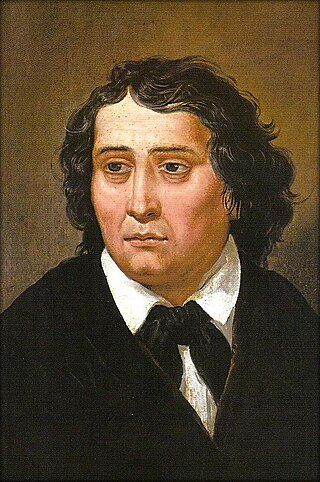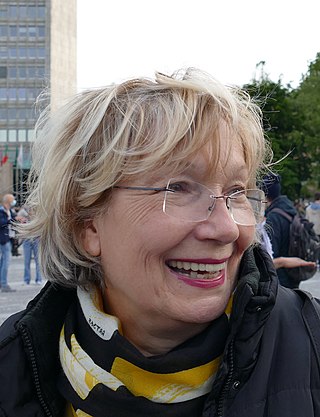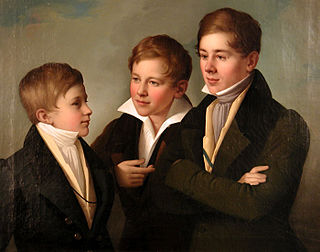
Slovenia officially the Republic of Slovenia is a country in Central Europe. It borders Italy to the west, Austria to the north, Hungary to the northeast, Croatia to the south and southeast, and a short coastline within the Adriatic Sea to the southwest, which is part of the Mediterranean sea. Slovenia is mostly mountainous and forested, covers 20,271 square kilometres (7,827 sq mi), and has a population of approximately 2.1 million. Slovene is the official language. Slovenia has a predominantly temperate continental climate, with the exception of the Slovene Littoral and the Julian Alps. Ljubljana, the capital and largest city of Slovenia, is geographically situated near the centre of the country. Other larger urban centers are Maribor, Kranj, Celje and Koper.

France Prešeren was a 19th-century Romantic Slovene poet whose poems have been translated into many languages.
Slovene literature is the literature written in Slovene. It spans across all literary genres with historically the Slovene historical fiction as the most widespread Slovene fiction genre. The Romantic 19th-century epic poetry written by the leading name of the Slovene literary canon, France Prešeren, inspired virtually all subsequent Slovene literature.

Rihard Jakopič was a Slovene painter. He was the leading Slovene Impressionist painter, patron of arts and theoretician. Together with Matej Sternen, Matija Jama and Ivan Grohar, he is considered the pioneer of Slovene Impressionist painting.

Ivan Grohar was a Slovene Impressionist painter. Together with Rihard Jakopič, Matej Sternen, and Matija Jama, he is considered one of the leading figures of Slovene impressionism in the fin de siecle period. He is known by his landscapes and portraits. He was also an established guitarist and singer.

Slovene culture is the culture of the Slovenes, a south Slavic ethnic group. It is incredibly diverse for the country's small size, spanning the southern portion of Central Europe, being the melting pot of Slavic, Germanic and Romance cultures while encompassing parts of the Eastern Alps, the Pannonian Basin, the Balkan Peninsula and the Mediterranean.

Edvard Kocbek was a Slovenian Yugoslav poet, writer, essayist, translator, member of Christian Socialists in the Liberation Front of the Slovene Nation and Slovene Partisans. He is considered one of the best authors who have written in Slovene, and one of the best Slovene poets after Prešeren. His political role during and after World War II made him one of the most controversial figures in Slovenia in the 20th century.

The Slovene lands or Slovenian lands is the historical denomination for the territories in Central and Southern Europe where people primarily spoke Slovene. The Slovene lands were part of the Illyrian provinces, the Austrian Empire and Austria-Hungary. They encompassed Carniola, southern part of Carinthia, southern part of Styria, Istria, Gorizia and Gradisca, Trieste, and Prekmurje. Their territory more or less corresponds to modern Slovenia and the adjacent territories in Italy, Austria, Hungary, and Croatia, where autochthonous Slovene minorities live. The areas surrounding present-day Slovenia were never homogeneously ethnically Slovene.

Alojz Gradnik was a Slovenian poet and translator.

The National symbols of Slovenia are the symbols used in Slovenia and abroad to represent the nation and its people.

Jakob Savinšek was a Slovene sculptor, illustrator, and poet.

The National Gallery of Slovenia is the national art gallery of Slovenia. It is located in the capital Ljubljana. It was founded in 1918, after the dissolution of Austria-Hungary and the establishment of the State of Slovenes, Croats and Serbs. Initially, it was hosted in the Kresija Palace of Ljubljana, but moved to the present location in 1925.

Libušnje is a small village in the Municipality of Kobarid in the Littoral region of Slovenia.

Spodnja Sorica is a village in the Municipality of Železniki in the Upper Carniola region of Slovenia.

Log pod Mangartom, is a settlement in the Municipality of Bovec in the Littoral region of Slovenia. It comprises the former villages of Gorenji Log and Spodnji Log as well as the hamlets of Loška Koritnica, Možnica, and Pustina.

Leskovica is a village in the Municipality of Gorenja Vas–Poljane in the Upper Carniola region of Slovenia. It is around 35 kilometers (22 mi) northwest of Ljubljana.

Alenka Sottler is a Slovene painter and illustrator. She lives and works in Ljubljana as a freelance illustrator and is a member of New York Society of Illustrators. She has illustrated over 50 books for children and adults, for which she received numerous awards and honours including her second nomination for the Hans Christian Andersen Award in 2014.

Art of Slovenia refers to all forms of visual art in or associated with Slovenia, both before and after the country's Independence from Yugoslavia in 1991. Art in Slovenia has been shaped by a number of Slovenian painters, sculptors, architects, photographers, graphics artists, comics, illustration, and conceptual artists. The most prestigious institutions exhibiting works of Slovene visual artists are the National Gallery of Slovenia and the Museum of Modern Art in Ljubljana.

Hinko Smrekar was a Slovenian painter, draughtsman, caricaturist, graphic artist, and illustrator. Smrekar was a member of the Vesna Art Club, which was active in Vienna, and a partisan in the Liberation Front of the Slovene Nation during the Nazi occupation of Yugoslavia. The Hinko Smrekar Primary School in Ljubljana and the Hinko Smrekar Prize in Celje, the highest Slovenian award in the field of illustration, are named after him. At the time when, as a collaborator of the Slovene Liberation Front, he was hastily shot by the Italian fascists in the vicinity of the gravel pit used for summary executions, he was living in the "Villa Kurnik" on Alešovčeva Street in Šiška. He is buried in the Memorial Park of Fallen Combatants and Hostages at Žale.

















